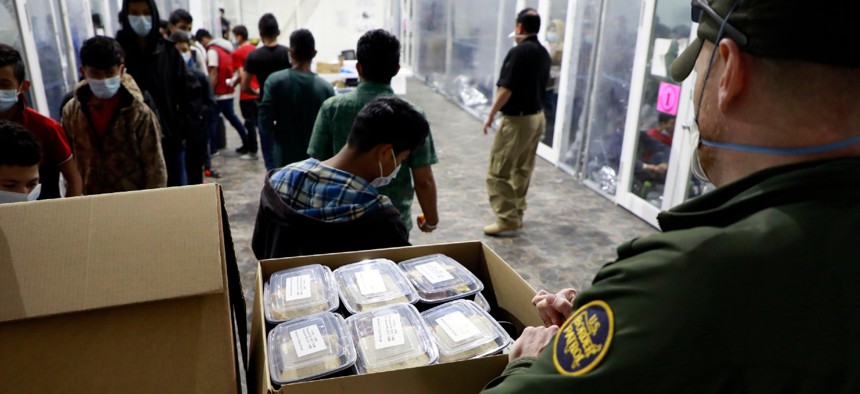
A Border Patrol agent works at a temporary processing facility in Donna, Texas, in March. Jaime Rodriguez Sr. / CBP
Biden Administration Reviewing Whether Trump's Proposed DHS Hiring Sprees Were Ever Really Necessary
Homeland Security officials are developing a new staffing model for border personnel after hiccups under Trump.
The Biden administration is in the midst of reviewing the staffing strategies pursued at the Homeland Security Department under President Trump, conducting an assessment officials said will better align the department's workforce with operational needs.
The Trump administration failed to identify the staffing requirements necessary for border security as required by federal statute, the Government Accountability Office found in a report issued this week, despite a mandate by the former president to hire thousands of agents. Now, the Biden administration is looking to revamp the process used to determine DHS’ workforce needs. It is both developing its own system to determine Customs and Border Protection personnel requirements and creating a new staffing model.
CBP completed that model last month, agency officials told GAO, and it is now under review by leadership.
President Biden put forward a fiscal 2022 discretionary spending preview last week that proposed an overall non-defense discretionary increase of 16%, but it did not include component-level funding proposals at DHS. The department was the only major agency in the blueprint whose funding would stay essentially flat, with a proposal to virtually freeze its appropriation at $52 billion. The White House proposed $1.2 billion for “border infrastructure,” but did not mention any hiring as part of that plan.
The only mention of personnel at CBP and Immigration and Customs Enforcement in the budget preview was a proposed 22% surge in funding at both agencies’ Offices of Professional Responsibility to ensure proper investigations of complaints lodged against their workforces, including “those related to white supremacy or ideological and non-ideological beliefs.” CBP launched an internal investigation after ProPublica in 2019 exposed a Facebook group in which employees were posting racist, sexist and xenophobic content, subsequently disciplining several workers.
Congress in 2017 mandated a DHS “border security improvement plan” to include details on staffing requirements, but GAO found the plan issued years later did not include the information. CBP officials said conducting such an evaluation “was deemed too lengthy a process,” so it opted not to go through with it. The congressional requirement followed Trump’s mandate for CBP to hire 5,000 additional Border Patrol agents and ICE to onboard 10,000 enforcement personnel. The DHS inspector general repeatedly faulted the department for failing to justify its staffing decisions.
Ultimately, Congress blocked Trump from meeting his stated DHS hiring targets. The department was forced to cancel multiple contracts aimed at bringing in outside help to onboard thousands of personnel due to a failure to deliver results. DHS has struggled for years to maintain adequate staffing—consistently falling below various congressional mandated floors—though officials said midway through Trump’s term they had finally begun to bring on more employees than they were losing.
The Biden administration’s review of CBP’s “personnel requirements determination process” and its new staffing model will align workforce levels “to current and future operational needs,” agency officials told GAO. Leadership made clear it will sign off on any recommendations made as part of the review. CBP and DHS declined to comment in time for this story.
Mark Morgan, who briefly led the Border Patrol under President Obama and headed up both ICE and CBP under Trump, defended the previous administration’s approach to staff modeling, saying leadership “put a tremendous amount of resources” into determining workforce needs. He said CBP evaluated the volume of vehicles and airplanes coming into ports of entry, migrant patterns, advancements in technology and other factors to determine the appropriate number of employees across the country.
“We didn’t just put up numbers and say, ‘OK, that’s great,’” Morgan said, adding he was regularly issuing justifications during the budgeting and appropriations process. “All of that is challenged. All of that is questioned.”
He explained that all federal agencies should and are constantly reevaluating their personnel needs and cautioned the Biden administration against targeting immigration and border agencies specifically. He called the current system “pretty effective,” though he conceded it could be fine tuned.
“I’m not saying it’s perfect,” Morgan said. “I’m not saying it can’t be improved.”
Elsewhere in DHS, Biden has proposed a $345 million appropriations increase for the primarily fee-funded U.S. Citizenship and Immigration Services. The White House said the funds would allow USCIS, which operated under a hiring freeze for several months at the end of the Trump administration, to address a growing backlog of cases. It also requested a funding surge to continue hiring of cybersecurity experts.







